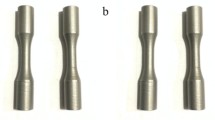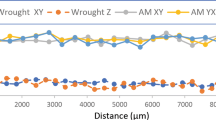Abstract
Extensive research on additive manufacturing (AM) has revealed its potential as well as its limitations. The components produced by AM usually do not meet the standard for direct end-use due to poor dimensional tolerance and surface finish. Therefore, subtractive manufacturing (SM) like machining and grinding are required to finish AM parts. The layer-by-layer deposition of the AM process yields components with high anisotropic properties and residual stress. Consequently, the SM characteristics of AM samples are reported to be very different from conventionally produced components. It necessitates significant research work on the SM characteristics of AM produced parts. The present study reports grinding of additively manufactured selective laser melted (SLM) Ti-6Al-4V and compares the grinding characteristics with rolled Ti-6Al-4V. The SLM samples were heat-treated before grinding to eliminate the effect of above-mentioned AM induced characteristics. The microstructure of the SLM samples did not reveal any sign of layered deposition owing to the heat treatment process. The samples were also found to be free from SLM-induced residual stress. Consequently, the differences observed in the grinding characteristics of SLM and rolled samples are not very substantial. The noticed differences in force, surface roughness, and residual stress can be attributed to their different hardness. Hence, the results of the present work suggest carrying out a proper heat treatment to the SLM-produced components before grinding so that the anomalous grinding behaviour can be avoided.










Similar content being viewed by others
References
Brinksmeier E, Cammett JT, König W, Leskovar P, Peters J, Tönshoff HK (1982) Residual stresses—measurement and causes in machining processes. CIRP Ann 31(2):491–510
Chattopadhyay AB (2011) Machining and machine tools (With CD), Wiley, 2011.
Chen W (2000) Cutting forces and surface finish when machining medium hardness steel using CBN tools. Int J Mach Tools Manuf 40(3):455–466
Choudhary A, Naskar A, Paul S (2018) Effect of minimum quantity lubrication on surface integrity in high-speed grinding of sintered alumina using single layer diamond grinding wheel. Ceramics Int 44(14): 17013–17021.
Denlinger ER, Michaleris P (2017) Mitigation of distortion in large additive manufacturing parts. Proc Inst Mech Eng Part b 231(6):983–993
Ghosh S, Chattopadhyay AB, Paul S (2008) Modelling of specific energy requirement during high-efficiency deep grinding. Int J Mach Tools Manuf 48(11):1242–1253
Hadad MJ, Tawakoli T, Sadeghi MH, Sadeghi B (2012) Temperature and energy partition in minimum quantity lubrication-MQL grinding process. Int J Mach Tools Manuf 54:10–17
Heigel JC, Phan TQ, Fox JC, Gnaupel-Herold TH (2018) Experimental investigation of residual stress and its impact on machining in hybrid additive/subtractive manufacturing. Proc Manuf 26:929–940
Huang SH, Liu P, Mokasdar A, Hou L (2013) Additive manufacturing and its societal impact: a literature review. Int J Adv Manuf Technol 67(5–8):1191–1203
Klocke, Fritz, Sein Leung Soo, Bernhard Karpuschewski, John A. Webster, Donka Novovic, Amr Elfizy, Dragos A Axinte, and Stefan Tönissen (2015) Abrasive machining of advanced aerospace alloys and composites. CIRP Ann 64(2): 581–604.
Lane BM, Moylan SP, Whitenton EP (2015) Post-process machining of additive manufactured stainless steel. In: Proceedings of the 2015 ASPE spring topical meeting: achieving precision tolerances in additive manufacturing, pp 27–29.
Leuders S, Thöne M, Riemer A, Niendorf T, Tröster T, Richard HAA, Maier HJ (2013) On the mechanical behaviour of titanium alloy TiAl6V4 manufactured by selective laser melting: Fatigue resistance and crack growth performance. Int J Fatigue 48: 300–307.
Liu Z, Li X, Wang X, Tian C, Wang L (2019) Comparative investigation on grindability of Inconel 718 made by selective laser melting (SLM) and casting. Int J Adv Manuf Technol 100(9–12):3155–3166
Malkin S, Guo C (2008) Grinding technology: theory and application of machining with abrasives. Industrial Press Inc.
Naskar A, Bhushan Singh B, Choudhary A, Paul S (2018) Effect of different grinding fluids applied in minimum quantity cooling-lubrication mode on surface integrity in cBN grinding of Inconel 718. J Manuf Processes 36: 44–50.
Naskar A, Choudhary A, Paul S (2020) Wear mechanism in high-speed superabrasive grinding of titanium alloy and its effect on surface integrity. Wear 462: 203475.
Ostra T, Alonso U, Veiga F, Ortiz M, Ramiro P, Alberdi A (2019) Analysis of the machining process of Inconel 718 parts manufactured by laser metal deposition. Materials 12(13):2159
Paul S, Ghosh A (2019) Suitability of aqueous MoS2 nanofluid for small quantity cooling lubrication–assisted diamond grinding of WC-Co cermets. Proc Inst Mech Eng Part b 233(2):426–442
Prevey PS (1986) X-ray diffraction residual stress techniques. ASM International, ASM Handbook. 10: 380–392.
Salonitis K, D’Alvise L, Schoinochoritis B, Chantzis D (2016) Additive manufacturing and post-processing simulation: laser cladding followed by high speed machining. Int J Adv Manuf Technol 85(9–12):2401–2411
Shunmugavel M, Polishetty A, Goldberg M, Singh R, Littlefair G (2017) A comparative study of mechanical properties and machinability of wrought and additive manufactured (selective laser melting) titanium alloy–Ti-6Al-4V. Rapid Prototyping J.
Srivastava AK, Pavel R (2015) Grinding investigations of Ti-6Al-4V parts produced using direct metal laser sintering technology. Int J Mech Manuf Syst 8(5–6):223–242
Teicher U, Ghosh A, Chattopadhyay AB, Künanz K (2006) On the grindability of titanium alloy by brazed type monolayered superabrasive grinding wheels. Int J Mach Tools Manuf 46(6):620–622
Wawra H (1978) Die Kroner-Grenzen der Elastizitatsmoduln technisch wichtiger Werkstoffe: Teil II. Zahlenwerte zur Temperaturabhangingkeit der Moduln der Elemente. Z Metallkd 69(8):518–523
Author information
Authors and Affiliations
Corresponding author
Additional information
Publisher's Note
Springer Nature remains neutral with regard to jurisdictional claims in published maps and institutional affiliations.
Rights and permissions
About this article
Cite this article
Kandulna, R., Naskar, A. & Paul, S. Superabrasive Grinding Characteristics of Additively Manufactured Ti-6Al-4V. Trans Indian Natl. Acad. Eng. 7, 197–205 (2022). https://doi.org/10.1007/s41403-021-00259-2
Received:
Accepted:
Published:
Issue Date:
DOI: https://doi.org/10.1007/s41403-021-00259-2




